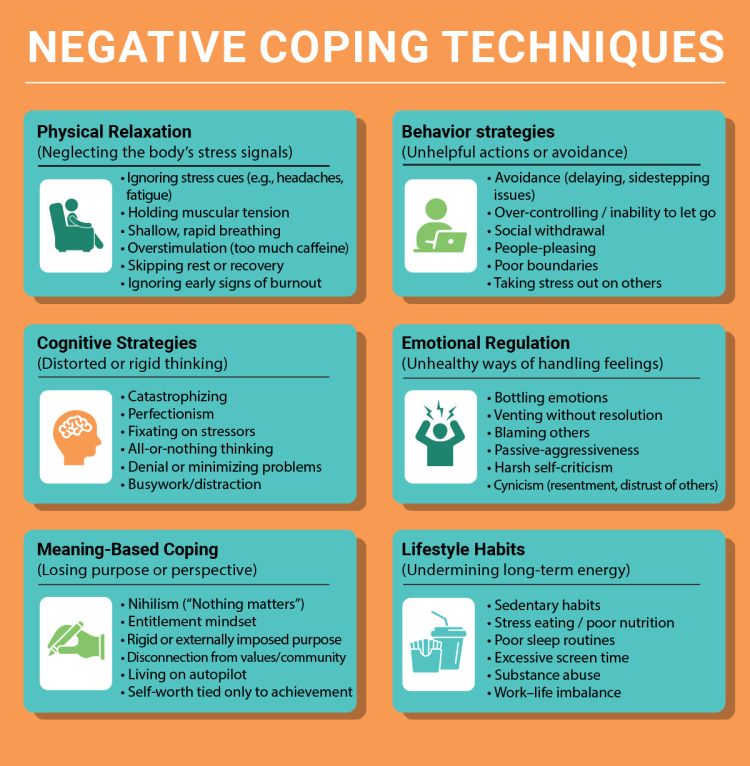Overcoming Unhealthy Stress Coping Methods
In my last post, I suggested that you are the CEO of your life—and that coping with stress requires the same kind of foresight and systems-thinking that successful companies rely on.
Businesses don’t thrive by clinging to one strategy; they adapt, pivot, and draw from a diverse inventory of approaches. The same is true for us: resilience comes not from grit alone, but from having a broad and flexible set of stress management strategies.
When Stress Narrows Your Coping Flexibility
Even so, there are times when our coping range shrinks. Under pressure, our perspective tightens. We lose patience, get reactive, and fall back on automatic habits. Some people can manage a heavy load of stressors without much disruption, while others constrict after just one or two challenges.
Either way, when our mental “aperture” narrows, we tend to rely on familiar patterns instead of adapting to the moment.
Recognizing Your Default Coping Responses

In my earlier blog, I introduced six categories of coping strategies—physical, behavioral, cognitive, emotional, meaning-based, and lifestyle. Together, they form a framework for building resilience through a diverse inventory of tools. But each category also has a darker side: the negative, unhealthy coping methods we fall back on when stress takes over.
We all have these defaults. Often, we know they’re unhelpful, yet they surface at the worst times. For example:
- Physical relaxation: You’ve tried to build healthy routines, but when stress hits, you default to numbing behaviors—slumping on the couch, drinking more than you should, or skipping the very activities that help you recharge.
- Behavioral strategies: You’ve worked hard to maintain balance. But when deadlines pile up, you slip back into overworking—logging long hours, canceling personal plans, and pushing yourself toward burnout.
- Cognitive strategies: You’ve practiced reframing negative thoughts. Yet under pressure, you catastrophize—imagining the worst-case scenario and fueling your own anxiety.
- Emotional regulation: You’ve learned to express feelings calmly. But in moments of duress, you lash out—snapping at loved ones or raising your voice, even when you promised yourself you wouldn’t.
- Meaning-based coping: You’ve begun to pursue writing as a way to deepen your sense of purpose. But when life feels overwhelming, you abandon it—slipping into thoughts like “What’s the point?” and losing touch with the activity that once inspired you.
- Lifestyle habits: You’ve committed to healthy eating and movement. Yet when stress builds, you turn to comfort food, late-night snacking, or skipping exercise.
These familiar incidents are default ways of coping with stress. They’re ingrained responses we learned long ago—often before we had the awareness or skills to question them. They feel natural because they’ve been rehearsed so many times.
Defaults aren’t always harmful. Sometimes they help in the short term. But when stress narrows our perspective, these automatic stress responses can resurface in ways that don’t serve us—reawakening patterns we may have long outgrown.
Steps to Overcome Unhealthy or Negative Stress Coping Patterns
The challenge is to become aware of your defaults and loosen their grip. Four practical steps can help you improve your coping repertoire:
- Take an inventory of your negative coping responses.
Notice which automatic reactions show up most often when you’re under pressure. Do you withdraw? Lash out? Overwork? The figure below lists common defaults across the six categories of coping strategies. Identify the ones that leave you feeling worse rather than better. - Choose one coping pattern to focus on.
Habits don’t change overnight, and tackling too much at once can backfire. Pick one negative pattern that would have the greatest impact on your well-being if you could shift it—your biggest “return on investment”. Focusing on one at a time increases your chance of lasting change. - Strengthen your motivation for change.
It’s easy to say you want to change. Real change comes when you feel the cost of staying the same. Reflect on what your default response has been costing you—strained relationships, lost energy, missed opportunities. Write it down. Read it aloud. Make the impact real enough that it fuels your desire to try something different. - Commit to a small, doable step.
Change begins with micro-steps, not sweeping overhauls. The goal is direction, not perfection. If your default is abandoning exercise when stressed, commit to a 10-minute brisk walk each day—enough to stay “in the game.” If your default is snapping at others, practice pausing and taking three deep breaths before responding. Small, consistent steps accumulate into real progress.
The Takeaway
Just as successful companies thrive by diversifying and adapting, they also focus on identifying and removing the barriers that hold them back.
The same is true for you: building resilience isn’t only about adding new coping strategies—it’s also about loosening the grip of the defaults that keep you stuck.
This week, notice your own default coping responses under stress. Write them down. Then pick one new stress management strategy to test the next time pressure builds. Over time, this practice builds exactly what every great leader relies on: the capacity to adapt, the foresight to prepare, and the resilience to thrive—not just in business, but in life.



